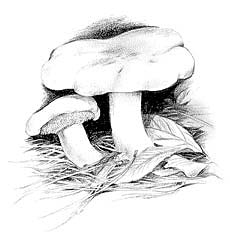Hedgehog MushroomHydnum repandumMushrooms with teeth? As a matter of fact, yes. Nothing intimidating, mind you, but these mushrooms do have small toothlike projections rather than gills on their lower cap surfaces. The tooth fungi, also known as "hedgehog" and "sweet tooth," appears in a variety of forms. Some grow as shelves on trees. Most are found on the ground. Colorful ones decorate the forest floor with their white, buff, red, orange-brown, blue, and purple caps. Several of the brightly colored wood varieties are used for dyeing woolen yarns. Only two kinds, Hydnum repandum and H. umbilicatum, are commonly eaten. Both are late bloomers, tending to appear in January along the Pacific Coast after other edible mushrooms have stopped fruiting. In the east they appear from July to November. 
Hydnum repandum is large, fleshy, buff colored, and found occasionally in groups under conifers or hardwood trees. White teethlike structures bear the spores. In a young specimen the teeth are firm. This is a good way to determine its age. When young, it has a mild, fresh odor, and it tastes best. Hydnum umbilicatum, sometimes called the belly-button mushroom, is found in the dense undergrowth under rhododendron bushes and other forest shrubbery. It is smaller and darker than H. repandum. The cap is an inch or less in diameter and is depressed in the middle like a belly button. It romps around through the leaves in troops. Clean as you would H. repandum. Tiny H. umbilicatum is delicious sautéed with butter until brown. This is a chewy mushroom with a prominent flavor enjoyed by children who won't eat most other wild mushrooms. Sauté quantities of these mushrooms to smother steaks and chops or pile onto toast or crackers. H. umbilicatum freezes well after being sautéed. Remember, only the young and firm are worth preserving. A number of varieties of gorgeously delicate, white, beardlike mushrooms are occasionally stumbled on in the woods. These are in the genus Hericium. They grow only on wood, sometimes under the bark of large fallen logs. Wash them in running water and inspect for insects. They may be prepared in any way, even served uncooked in salads, but should be used only when they are white, brittle, and young. Try combining them with onions, peas and a little soy sauce after first sautéing the mushroom in butter. Hericium erinaceus is now being cultivated in the United States, where it is called "bear's head" or "pom-pom blanc," and in China, where it is known as "monkey head." CleaningBrush their surfaces. Check the toothed undercaps for uninvited guests, and cut off damaged ends. Spread on paper towels to dry. H. repandum requires light brushing with a little water to clean debris from the cap. Try not to wet the underside. Blot dry on paper towels. CookingThe hedgehog mushroom has been described by some as having a mild chanterelle flavor. The color is similar to the white chanterelle. When older, they tend to be darker and taste bitter, so use only firm blond specimens. Their best use is in casseroles. PreservingIf you pickle H. repandum in vinegar and spices, it will last for a few weeks. It can be sautéed in butter and frozen. Drying toothed mushrooms is not advised. The mushrooms become fragile and grainy, and their teeth fall out. When reconstituted in water they are tough and tasteless. Vegetarian Pickled HerringServes 4 as an appetizer
Hedgehogs and VegetablesServes 4 as a side dish
Scalloped HedgehogsServes 4 as a side dish
ALTERNATE MUSHROOM: Common Store Mushroom Breast of Veal with Hedgehog MushroomsServe 4 to 6 as a main course
|